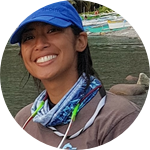About This Project
The Manta Bowl is a seamount located within the second largest protected seascape in the Philippines. Due to the area's characteristics, the area is a critical habitat for manta rays, whale sharks and other marine life. The project aims to explore the deeper areas (100-400m) around the seamount, describe its biodiversity and identify priority areas for conservation while enhancing deep sea exploration technologies and accessibility locally.
Ask the Scientists
Join The DiscussionWhat is the context of this research?
Due to their physical and environmental properties, seamounts have been known to act as biodiversity hotspots and can host numerous vulnerable marine ecosystem (VME) indicator species. Despite their abundance and ecological roles, less than 0.1 % of the world's seamounts have been explored. These vital ecosystems are under threats from human activities including unsustainable forms of fishing and deep-sea mining.
We will be developing low-cost deep sea drop cameras using off-the-shelf resources in order to assess the status and biodiversity of the deep-sea areas of the Manta Bowl seamount, contribute to deep-sea AI, and provide more insights to these ecosystems. Comparison studies with existing low-cost camera system, Maka Niu, will also be conducted.
What is the significance of this project?
Despite the area being situated inside a protected area, the current zoning allows for potentially damaging activities to occur, including oil and gas shipping and unloading, seismic exploration and fishing.
By identifying critical habitats and collecting baseline information on the current status of biodiversity, unsustainable activities can be managed and regulated to ensure the conservation of these important deep-sea waters.
The low-cost, open-source technology will also make deep sea research more accessible to students, early-career researchers and deep sea enthusiasts worldwide, subsequently increasing our knowledge of the deep sea and contributing to the Global Sustainable Development Goals.
What are the goals of the project?
The goals of the project are to
1.) Assess the deep-sea biodiversity and identify critical habitats in the waters of the Ticao-Buris Pass Protected Seascape (Philippines) with particular focus on the Manta Bowl seamount;
2.) Develop an efficient and easy-to-use, low-cost, deep-sea camera system, to increase accessibility to deep water exploration and research for local communities and research groups regionally and globally;
3.) Provide images from a poorly explored region of the world, to enhance AI and machine learning and support automated data management for the development of large scale deep sea citizen science projects.
Budget
The key for the success of this project is to develop a durable and easy to use low cost deep sea capable (up to 450m) camera system utilizing off the shelf component, so that the technology can be replicated and used by local research groups and communities across the world.
The items listed will be essential to the development and testing of this cameras, conduct of surveys around the Manta Bowl seamount, and compare the usability, cost and quality of the data collected in comparison with other existing deepwater cameras (Maka Niu).
Different release mechanisms, housing, batteries and camera combinations will be tested and compared, while collecting important data on the deep sea biodiversity around the seamount.
Footage will be also utilized in enhancing deep-sea machine learning and AI.
The additional enclosures will be depth rated up to 1500 meters and will be used to assess deeper areas of the protected seascape.
Endorsed by
 Project Timeline
Project Timeline
Deployment of deepwater BRUVS is timed so that data is analyzed and results are prepared before the Protected Area Management Board (PAMB) 3rd quarterly meeting. Further discussion will be made moving forward for the zoning classification of key/critical areas identified. All resources pertaining to the development of the deepwater BRUVS will be made open-access through online hosting platforms and the LAMAVE website.
Feb 09, 2023
Project Launched
Apr 20, 2023
Engineered low-cost, deepwater BRUVS using off-the-shelf equipment
Nov 06, 2023
Comparison study with Maka Niu
Nov 06, 2023
Tested prototype
Feb 01, 2024
Data Collection around the Manta Bowl Seamount
Meet the Team
Affiliates
Affiliates
Titus Cañete
Initially taking up Biology in pursuit of a future career in medicine, Titus fell in love with marine conservation and has since shifted his focus to protecting the beauty of the ocean. After graduating university, Titus pushed towards his career in marine conservation and has led assessments in coral, seagrass and mangrove conservation working closely with communities, local governments and national agencies for a collaborative approach towards sustainability. Titus joined LAMAVE in 2019 and led the Palawan Whale Shark Research and Conservation Project studying their population demographics in the area. Currently focused on the study of deep sea megafauna in the Philippines, Titus aims to discover, study and protect the unexplored depths of the sea.
Ariana Agustines
Ariana Agustines is a Filipina marine scientist and National Geographic Explorer, who is passionately curious about the natural world and determined to advance conservation strategies and sustainable management of marine megafauna, particularly elasmobranchs (sharks and rays) in Southeast Asia. Agustines holds a master’s degree in marine biotechnology. She has worked in several labs from ecotoxicology to marine microbiology, investigating the effects of harmful algal blooms and pesticides on several commercially important marine organisms to human application of elasmobranch mucus. Ultimately, the urgency for locally applied conservation actions brought her back home to the Philippines where her work focuses on understanding the ecology of threatened sharks and rays and how human activities impact their conservation status. Agustines is currently the vice president of the Large Marine Vertebrates Research Institute Philippines and the program manager of the Philippines Whale Shark Research and Conservation Project. She also supervises and runs the shark and ray conservation work across the country with her focus in Palawan, where she has been based since 2018. Agustines utilizes new technologies like satellite telemetry, animal-borne video cameras, remote and deep-sea cameras, eDNA, and genomics among others, to push the quest for knowledge to support informed management and direct engagement of the local stakeholders – particularly the tour operators and the small-scale fishers.
Additional Information
The deepwater BRUVS will be deployed around the deep areas of the seamount (depths 100-400 meters). Data and footage will presented to the Protected Area Management Board to further support effective zoning and strategies for the conservation of the deep-sea areas and biodiversity of the seamount.
Project Backers
- 16Backers
- 103%Funded
- $10,700Total Donations
- $668.75Average Donation



